When enough people believe that a piece of fake news will affect prices, it actually will affect prices.
Written by: David, Deep Tide TechFlow
The crypto market has its own "wolf is coming" story.
On August 3, the well-known foreign financial news platform First Squawk posted on social media: "China has officially banned cryptocurrency trading, mining, and related services, citing financial risks, capital flight issues, and environmental impacts."

Major overseas financial accounts with millions of followers, such as Investing.com and Rawsalerts, subsequently retweeted this unverified "breaking news." Clearly, using China's ban on cryptocurrency has become a "traditional skill" in the realm of crypto market fake news.
In the comments section of this news, there was a humorous comment — Grok, asking me, how many times has China banned cryptocurrency now?
Veteran investors have long been fatigued by such fake news, and Bitcoin's price has already become immune to this type of fake news.
However, there is indeed an absurd cycle in the crypto market — every so often, a highly influential piece of fake news will emerge.
You may be immune to the cycle of China's ban, but you may not be immune to the emergence of all fake news. When enough people believe that a piece of fake news will affect prices, it actually will affect prices.
China's "ban" is just the tip of the iceberg regarding the entire crypto market's susceptibility to fake news. Looking back at the entire history of the crypto market's development, those heavyweight pieces of fake news have indeed influenced the direction of crypto assets;
And behind a piece of fake news, you can even see a hidden information dissemination chain.
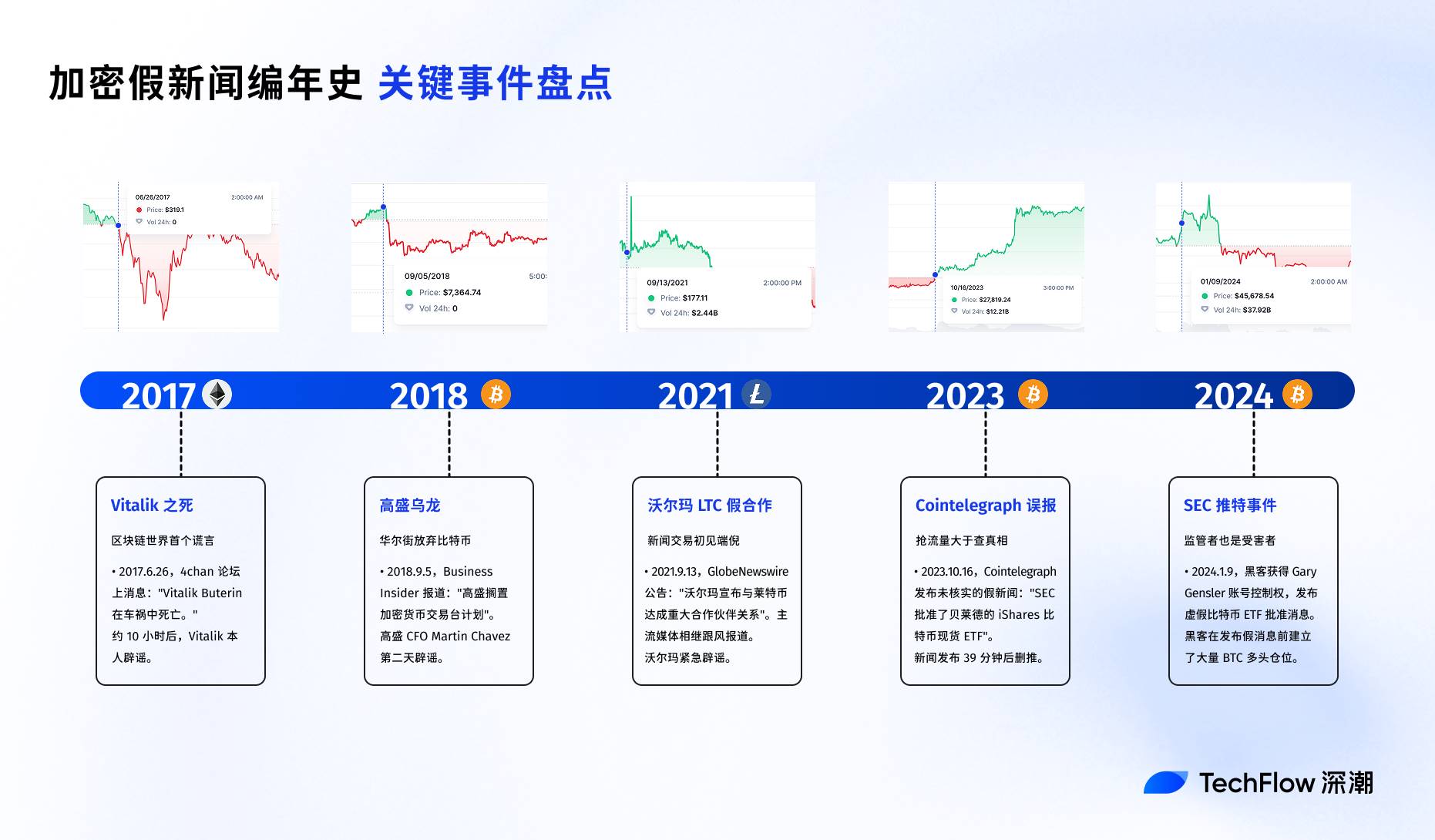
Chronicle of Crypto Fake News: From Amateur to Professional, Key Events Overview
- 2017: The Death of Vitalik, the First Lie in the Blockchain World
If we were to write an evolutionary history of cryptocurrency fake news, June 26, 2017, would undoubtedly be a milestone.
That afternoon, a message appeared on the well-known foreign forum 4chan: "Vitalik Buterin has died in a car accident." There was no source, no evidence, and not even any decent details.
But this crude rumor triggered the first market crash in cryptocurrency history caused by fake news within the next few hours. At that time, ETH plummeted from $317 to $216 in just 6 hours, a drop of nearly 32%.
The Reddit r/ethtrader section was filled with posts asking, "Is this true?" "Can anyone confirm?" In Telegram groups, holders debated whether they should sell immediately.
About 10 hours after the rumor spread, Vitalik himself posted a photo on Twitter holding the Ethereum block number and hash value from that day to debunk the rumor, using the blockchain itself to prove he was still alive.

Vitalik is still here, but your position may be gone.
The market's reaction at that time revealed a cruel truth: in the early wild west of the crypto world, the destructive power of an anonymous post could rival that of an official announcement.
Early fake news creators were mostly amateur players. They either set up so-called insider groups on Telegram or posted on forums like 4chan. This was a market with extreme information asymmetry, where retail investors groped in the dark, and any slight movement could trigger a stampede.
Fake news during this period resembled pranks by a few individuals, directly linking the personal safety of project founders to the survival of the projects.
- 2018: Goldman Sachs Blunder, Wall Street Abandons Bitcoin
When fake news donned a suit, the destructive power of professional "exclusive news" was even greater.
On September 5, 2018, the cryptocurrency market was shrouded in the gloom of a bear market. At this sensitive moment, the well-known American business website Business Insider published a report with the headline: "Goldman Sachs Shelves Cryptocurrency Trading Desk Plans."
The so-called "trading desk" is a department in investment banks that buys and sells specific financial products for clients. If Goldman Sachs really established a cryptocurrency trading desk, it would mean that its institutional clients could buy and sell Bitcoin through Goldman Sachs, which at the time was seen as an important milestone for cryptocurrency gaining mainstream recognition; while "shelving" hinted at the abandonment of cryptocurrency.
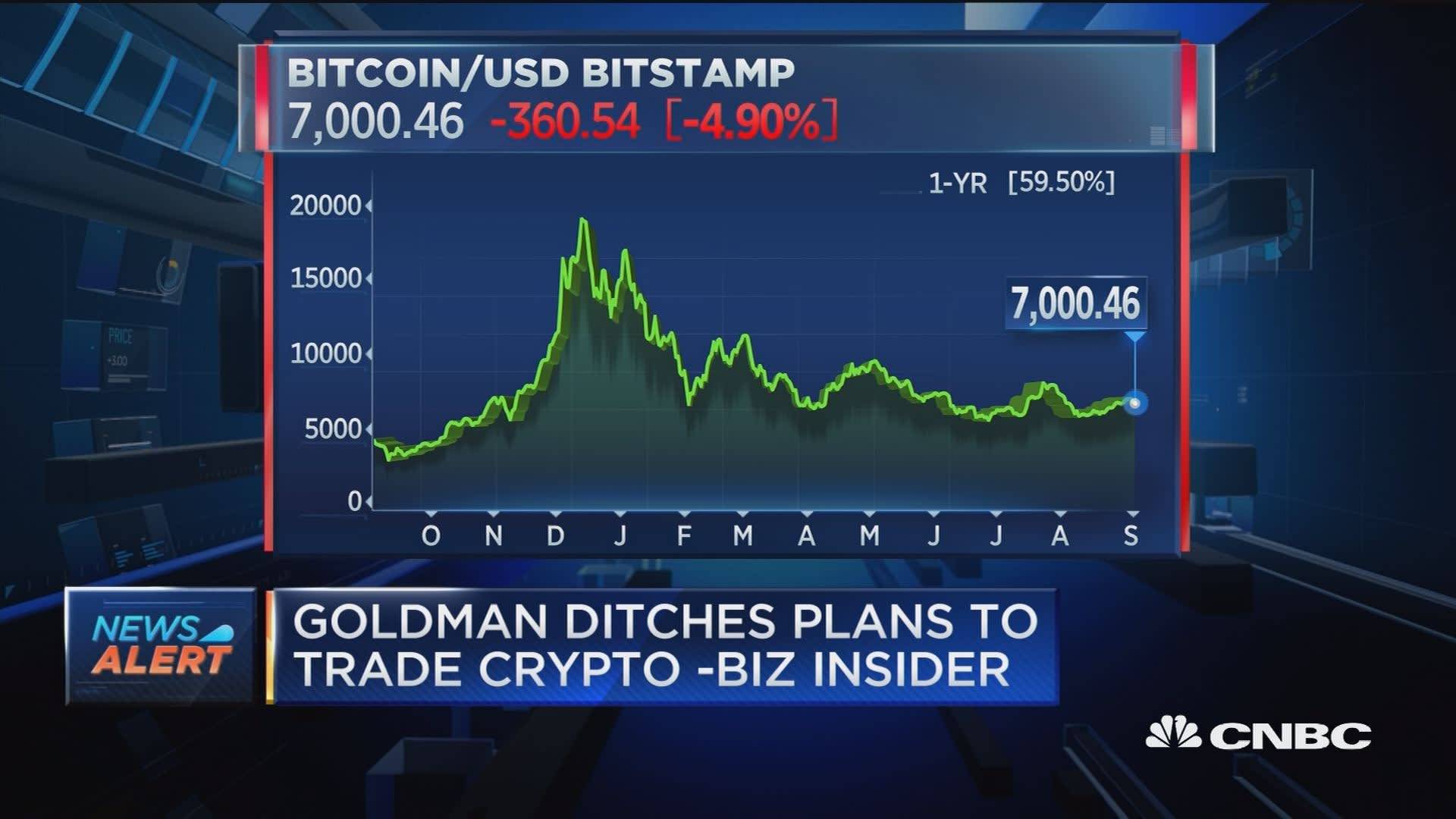
The next day, the plot reversed. When Goldman Sachs CFO Martin Chavez was asked about this at the TechCrunch conference, his response left everyone speechless: "I was wondering yesterday, when did I make this decision? This is fake news."
But the clarification came too late. In that panicked 24 hours, a large number of investors had already cut their positions and exited.
According to a report from Cointelegraph at the time, Bitcoin and other digital currencies plummeted in price following this so-called fake news from "insider sources," with the total market value dropping by $12 billion in just one hour, and Bitcoin falling over 6% that day.
- 2021: Walmart and Litecoin Fake Partnership, Signs of News Trading Emerged
If the previous fake news could still be seen as misunderstandings or oversights, then the fake news about Walmart and Litecoin's partnership on September 13, 2021, was a complete premeditated crime.
That morning at 9:30, one of the world's largest press release distribution services, GlobeNewswire, published an announcement.
The headline was eye-catching: "Walmart Announces Major Partnership with Litecoin." The press release was well-crafted, containing all the elements of a professional press release: Walmart's official logo, detailed partnership plans, quotes from executives, and even contact information for the investor relations department.
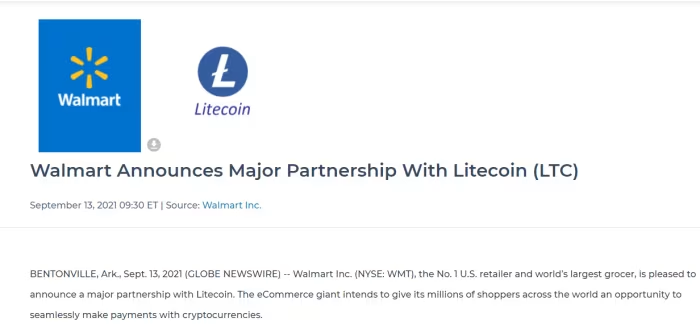
The press release claimed that starting October 1, all of Walmart's e-commerce sites would offer the option to "pay with Litecoin." It also quoted Walmart CEO Doug McMillon as saying, "Cryptocurrency will play an important role in our digital strategy."
Subsequently, some crypto media outlets rushed to report this information, and most critically, the official Twitter account of the Litecoin Foundation retweeted the news.
In that period when there was no "coin-stock linkage" play and crypto was not so mainstream, the market's reaction was explosive.
The price of Litecoin began to rise vertically, and trading volume surged. Mainstream media also joined the dissemination chain — CNBC and Reuters reported successively; by 10:30 that day, the price of Litecoin peaked, rising over 30%.
However, just as the market was caught in a frenzy, Walmart's PR team noticed the anomaly. They urgently verified and released a statement: this was fake news, and Walmart had no partnership with Litecoin.
After the news reversal, the price of Litecoin plummeted like a free fall. But for the manipulators behind the scenes, the game was already over.
Subsequent investigations revealed that 48 hours before the fake news was released, there had been unusual bullish options trading on Litecoin in the market. The manipulators profited millions of dollars from this scam through careful planning.
The terrifying aspect of this incident lay in its professionalism.
From registering similar domain names, creating fake press releases, to choosing the timing of the release and utilizing official account endorsements, every step was meticulously calculated. This was not the initial prank about Vitalik's death, but a more premeditated and organized crime, attempting to profit through news trading.
- 2023: Cointelegraph Misreporting, Traffic Over Truth
October 16, 2023, was a day worth reflecting on for the cryptocurrency media industry.
At 1:17 PM, a screenshot from a Telegram group began circulating in the crypto community. The screenshot showed a message allegedly from a Bloomberg terminal: the SEC had approved BlackRock's iShares Bitcoin spot ETF.
For cryptocurrency investors who had been waiting for years, this was undoubtedly a historic moment.
Cointelegraph's social media team saw this news. As one of the largest cryptocurrency media outlets globally, they certainly understood the weight of this news.
But before publishing, they faced a dilemma: should they take the time to verify thoroughly, risking being scooped by other media? Or should they publish immediately to seize the traffic advantage?
At 1:24 PM, just 7 minutes later, Cointelegraph published this "breaking news" on its official X account. The tweet was very eye-catching: "Breaking: SEC Approves BlackRock's Spot Bitcoin ETF."
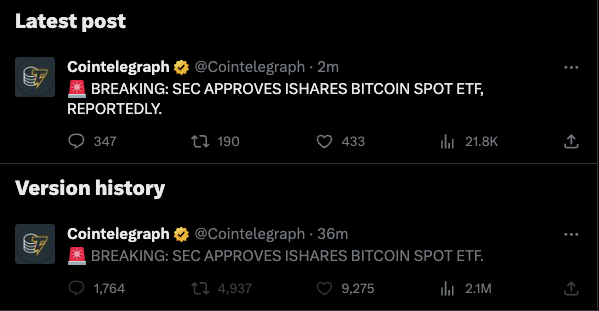
The market's reaction was immediate and intense, with Bitcoin's price soaring from $27,900 to $30,000 in the next 30 minutes, an increase of over 7%; trading volume surged, and the servers of major exchanges felt the pressure. The derivatives market was even crazier, with $81 million in short positions being forcibly liquidated in this surge.
However, excitement quickly turned into confusion. Observant individuals began to raise questions:
Why was only Cointelegraph reporting this? Why was there no announcement on the SEC's official website, and why was BlackRock silent?
At 2:03 PM, 39 minutes after the tweet was published, Cointelegraph deleted the original tweet. But the damage had already been done. In less than an hour, the market had experienced a complete cycle of rise and fall.
According to a subsequent investigation report released by the media, the error stemmed from a breakdown in internal processes — the social media editor violated the rule requiring editorial confirmation before publication.
This incident sparked intense discussions within the industry. A sharp viewpoint emerged: when media prioritizes speed over accuracy, they are no longer media but tools of market manipulation.
Crypto media faces immense pressure. This is a 24/7 market where news can break at any time. If you are five minutes late, the traffic is snatched away by others. In this environment, publishing first and verifying later is a risky but highly rewarding choice, but it may come at the cost of credibility.
In traditional financial markets, significant news is usually released uniformly through official channels, with strict information disclosure rules. However, in the crypto market, information channels are decentralized, making it difficult to distinguish between true and false. A screenshot or a tweet can trigger billions of dollars in capital movement.
Ironically, when the SEC actually approves a Bitcoin ETF in January 2024, the market's first reaction is not cheers, but skepticism.
- 2024: SEC Twitter Incident, Regulators Are Also Victims
In January 2024, the official SEC X account published false news about the approval of a Bitcoin ETF. According to subsequent FBI investigations, the attackers gained control of the account through a SIM swap attack. After the fake news was released, the price of Bitcoin rose from $46,600 to $47,680, and then fell to $45,627 after the rumor was debunked.
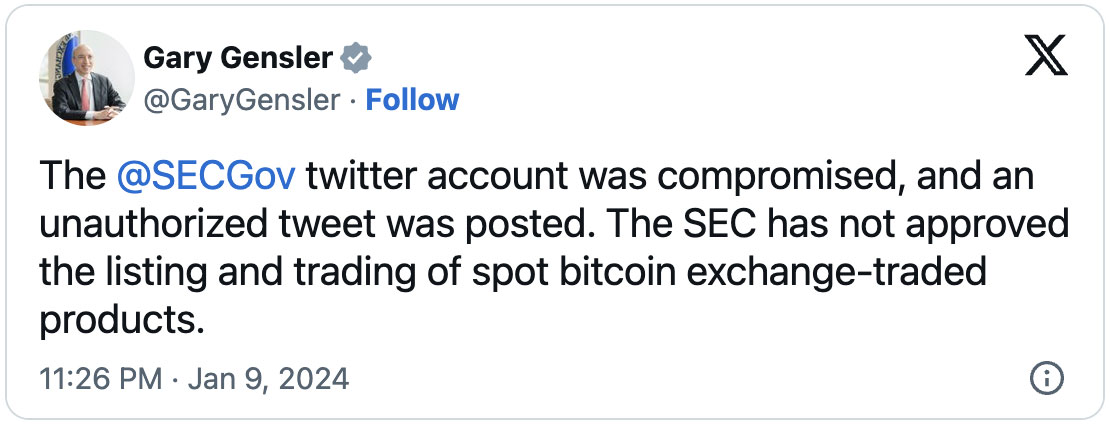
In October 2024, the FBI arrested suspect Eric Council Jr. Court documents revealed that this was a premeditated financial crime, with the attacker having established a large number of long positions in Bitcoin before releasing the fake news.
Over the past decade, cryptocurrency fake news has transitioned from "unintentional mistakes" to "premeditated crimes." The technical barriers, scale of funding, and level of organization have all upgraded; you may have dodged one instance of fake news, but you cannot guarantee that you won't fall for the next one.
Three People Make a Tiger, When the Truth is Diluted
In the crypto market, tracking the source of a piece of fake news is often futile.
When news like "China bans cryptocurrency again" stirs the market, the sheer volume of retweets, algorithmic recommendations, and the rise of self-media discourse make it impossible to pinpoint where the information originally came from.
A typical path of crypto fake news dissemination might look like this:
First Layer Source is usually a small Telegram channel or Discord group, making it nearly impossible to trace the origin. The publishers often use anonymous accounts, suffering no loss even if exposed;
Second Layer Small Circle Fermentation spreads among several related groups, starting to add "evidence" — PS images, fabricated details, seemingly plausible logic, etc.;
Third Layer Crypto Media Platforms give the news a "quasi-official" color. Even if disclaimers like "according to informed sources" are used, readers often choose to ignore them.
Fourth Layer KOL Involvement, when the news spreads to a certain extent, KOLs face a choice: to post or not to post? Most choose a strategy of "retweeting but not endorsing" — using phrases like "it is said" or "there are reports that."
Fifth Layer Market Reaction, once prices start to fluctuate, the fake news gains "market validation." The decline itself becomes "evidence" of the news's authenticity.
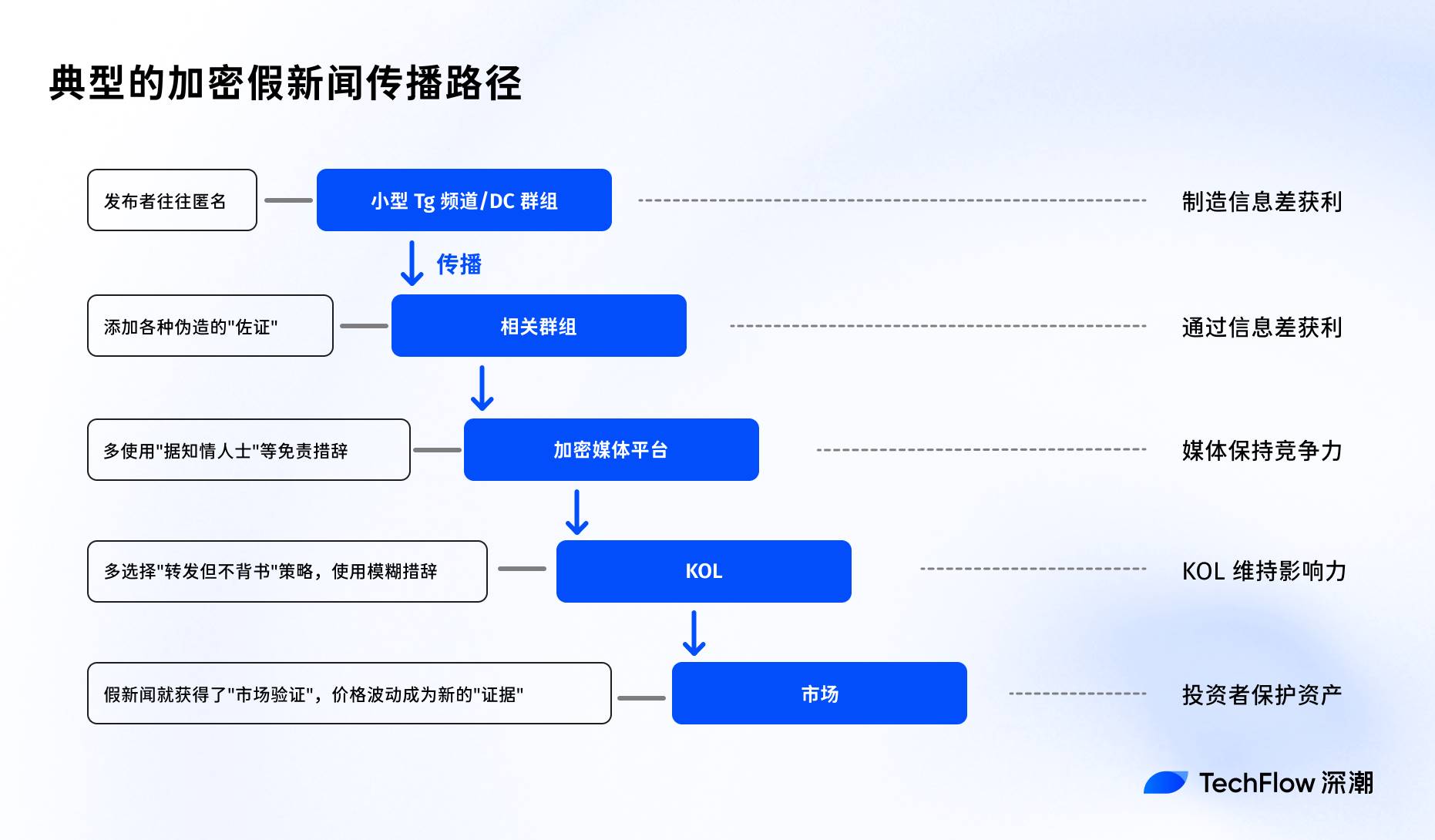
When a piece of news has gone through multiple layers of dissemination, tracing its source becomes nearly impossible. Each layer of transmission adds new "details," introducing new interpretations until the original information is completely diluted.
In the crypto market, rumors can spread irresponsibly and rapidly, while debunking them requires rigorous evidence and logic. Spreading panic/exclusive news may create trading opportunities, but spreading debunking news yields no direct benefits.
Each participant acts rationally based on their own interests, but all these "rational" choices combined create a collectively irrational outcome.
The market is repeatedly fooled by fake news, yet it seems no one can or wants to break this cycle.
Perhaps this is the new meaning of "Three People Make a Tiger" in the crypto era: it is not that three people saying something will make it true, but when enough people believe it will affect the market, it truly does affect the market.
In this process, the truth itself becomes less important.
免责声明:本文章仅代表作者个人观点,不代表本平台的立场和观点。本文章仅供信息分享,不构成对任何人的任何投资建议。用户与作者之间的任何争议,与本平台无关。如网页中刊载的文章或图片涉及侵权,请提供相关的权利证明和身份证明发送邮件到support@aicoin.com,本平台相关工作人员将会进行核查。




